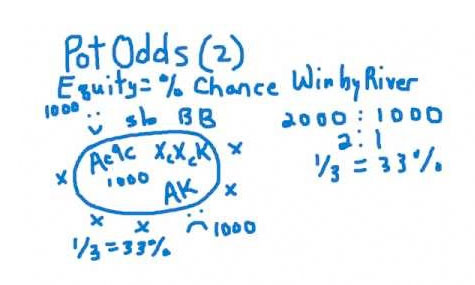Poker Odds Strategy | How to calculate pot odds and equity: equity
How to calculate pot odds and equity: equity

As you read in the first part, being able to make out the odds on the pot is one of the ways of getting to winning. With the pot odds, you also need to calculate your pot equity and compare the two.
In the previous article, you learned how to calculate pot odds when at the table. This next step is equally important and it is much easier than the first concept.
Equity on the hand
Here, you will need to have a sum total of your outs. If you remember, equity is the odds you have at winning the pot, and in order to calculate it, you must first know the exact number of your outs you have in order to make a hand. This will take a little practice and memorizing in order to be able to use it.
Bear in mind: there are 13 cards of all type suits and 4 of every value.
With your straight open ended draw, you require two different value cards in order to get your hand. This is to say 2*4 is equal to 8 outs. There are 13 suit cards for your flush draw. If you hold two of these and there are two on the board, you will have 13- 2- 2 which equals 9 outs.
You should always out cards you know from your hand and board and never double count. You should also consider the concept of anti outs when counting your outs and even the blockers. This is to say that, incase you complete your opponent's flush while making your straight, you should not consider the straight cards as your hand's outs as they are not and thus should not be counted as outs.
It is possible to turn an 8out straight draw that is profitable to a 6out draw by having a board flush draw and this will make your odds limited.
If you are finding it hard to make out the value of your opponent's hand, you need to play safe by assuming that they have a hand much more superior than yours. In case of a flush draw, you need to assume that your opponent has the draw, incase there is a paired board, you need to assume that your opponent's has a full house, or you can jump strips if you are lucky. It is better to make the mistake of folding a hand than to make the mistake of calling on your entire stack.
If the above is really complex for you to understand, just remember this rule: always multiply your outs by 4 on the flops, always multiply your outs by 2 on the turns.
This will equate to 32% ability for you to make your straight with two cards coming with a straight open ended draw. The hands on the flop with outs greater than eight, you can use the formula below to get a more accurate deduction:
The no. of outs multiplied by 4 minus the number of outs minus 8 will equal to equity i.e.
Outs *4 – outs (– 8) = equity. Equating this to straight open ended flush draw with 15 outs and the equity will be: 15*4 – (15-8) = 53%
Using this formula, there could be a percentage that is higher by at least seven points and this would equal to bigger results. With incorrect equity calculations, it will be impossible for you to make wise decisions that day.
Combining the two
In the previous article on odds ratio, we ended with the call button being offered a 3:3:1 cut off odds. Since you are able to calculate the odds and you know the equity, it will be proper to convert the equity to a ration in order for the two to work together. Using the formula from the previous article:
With 32% it means that you have 32 out of the whole 100, thus 100 – 32 = 68. This means that the odds are at 68:32, but you need to simplify this number and if you apply the technique from the previous article you will end up with your pot odds at 2.1: 1.
In order for you to make any money, you require pot odds that are higher than what you have above. with your straight open ended draw at 2.1:1, your cut off draw from the previous article's example were at 2.3:1, this is to say that, the cut off has enough odds at the pot to call.
If you are at the button, the cut off calls, you will have your odds at 3.3:1. You only needed odds at 2.1:1 to win, this means that calling has proven to be of value after all. With this outcome, you will need to play with one part of the odds range; this is because you did not put into consideration to the odds implied.
The implied odds have very deep effects on no limit hold'em. You can rely of the height of the implied odds to deduce the accuracy of the call, even when the odds on the pot do not allow it.
As you have seen above, you only require understanding the calculations of the equity and pot odds in order to make informed decisions. You simply have to make an effort to memorize the formulas and practice often. It might be harder for some people than others, but you will eventually understand it in the long run and enjoy the wins.
- Learn How to Calculate Pot Odds in Poker





1 Comment